Related Research Articles

"Ode to a Nightingale" is a poem by John Keats written either in the garden of the Spaniards Inn, Hampstead, London or, according to Keats' friend Charles Armitage Brown, under a plum tree in the garden of Keats' house at Wentworth Place, also in Hampstead. According to Brown, a nightingale had built its nest near the house that he shared with Keats in the spring of 1819. Inspired by the bird's song, Keats composed the poem in one day. It soon became one of his 1819 odes and was first published in Annals of the Fine Arts the following July. The poem is one of the most frequently anthologized in the English language.

"Ode on a Grecian Urn" is a poem written by the English Romantic poet John Keats in May 1819, first published anonymously in Annals of the Fine Arts for 1819.

Samson Agonistes is a tragic closet drama by John Milton. It appeared with the publication of Milton's Paradise Regained in 1671, as the title page of that volume states: "Paradise Regained / A Poem / In IV Books / To Which Is Added / Samson Agonistes". It is generally thought that Samson Agonistes was begun around the same time as Paradise Regained but was completed after the larger work, possibly very close to the date of publishing, but there is no certainty.
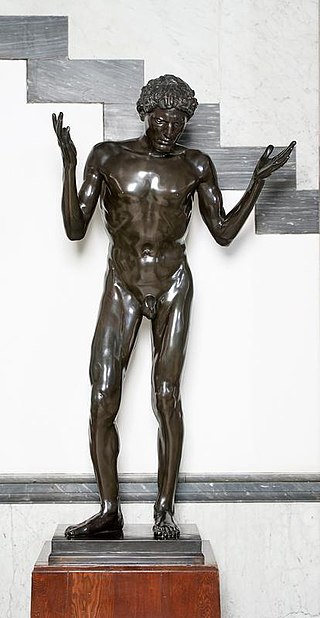
"Lycidas" is a poem by John Milton, written in 1637 as a pastoral elegy. It first appeared in a 1638 collection of elegies, Justa Edouardo King Naufrago, dedicated to the memory of Edward King, a friend of Milton at Cambridge who drowned when his ship sank in the Irish Sea off the coast of Wales in August 1637. The poem is 193 lines in length and is irregularly rhymed. Many of the other poems in the compilation are in Greek and Latin, but "Lycidas" is one of the poems written in English. Milton republished the poem in 1645.
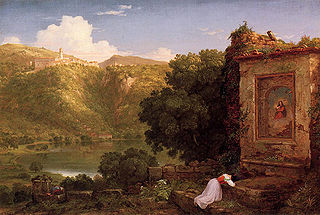
Il Penseroso is a poem by John Milton, first found in the 1645/1646 quarto of verses The Poems of Mr. John Milton, both English and Latin, published by Humphrey Moseley. It was presented as a companion piece to L'Allegro, a vision of poetic mirth. The speaker of this reflective ode dispels "vain deluding Joys" from his mind in a ten-line prelude, before invoking "divinest Melancholy" to inspire his future verses. The melancholic mood is idealised by the speaker as a means by which to "attain / To something like prophetic strain," and for the central action of Il Penseroso – which, like L'Allegro, proceeds in couplets of iambic tetrameter – the speaker speculates about the poetic inspiration that would transpire if the imagined goddess of Melancholy he invokes were his Muse. The highly digressive style Milton employs in L'Allegro and Il Penseroso dually precludes any summary of the poems' dramatic action as it renders them interpretively ambiguous to critics. However, it can surely be said that the vision of poetic inspiration offered by the speaker of Il Penseroso is an allegorical exploration of a contemplative paradigm of poetic genre.
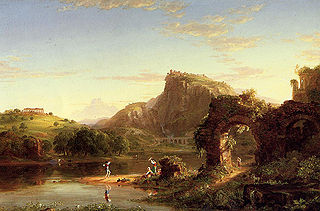
L'Allegro is a pastoral poem by John Milton published in his 1645 Poems. L'Allegro has from its first appearance been paired with the contrasting pastoral poem, Il Penseroso, which depicts a similar day spent in contemplation and thought.

Milton's 1645 Poems is a collection, divided into separate English and Latin sections, of John Milton's youthful poetry in a variety of genres, including such notable works as An Ode on the Morning of Christ's Nativity, Comus and Lycidas. Appearing in late 1645 or 1646, the octavo volume, whose full title is Poems of Mr. John Milton both English and Latin, compos'd at several times, was issued by the Royalist publisher Humphrey Moseley. In 1673, a year before his death, Milton issued a revised and expanded edition of the Poems.

"Ode: Intimations of Immortality from Recollections of Early Childhood" is a poem by William Wordsworth, completed in 1804 and published in Poems, in Two Volumes (1807). The poem was completed in two parts, with the first four stanzas written among a series of poems composed in 1802 about childhood. The first part of the poem was completed on 27 March 1802 and a copy was provided to Wordsworth's friend and fellow poet, Samuel Taylor Coleridge, who responded with his own poem, "Dejection: An Ode", in April. The fourth stanza of the ode ends with a question, and Wordsworth was finally able to answer it with seven additional stanzas completed in early 1804. It was first printed as "Ode" in 1807, and it was not until 1815 that it was edited and reworked to the version that is currently known, "Ode: Intimations of Immortality".

The Lucy poems are a series of five poems composed by the English Romantic poet William Wordsworth (1770–1850) between 1798 and 1801. All but one were first published during 1800 in the second edition of Lyrical Ballads, a collaboration between Wordsworth and Samuel Taylor Coleridge that was both Wordsworth's first major publication and a milestone in the early English Romantic movement. In the series, Wordsworth sought to write unaffected English verse infused with abstract ideals of beauty, nature, love, longing, and death.
Of Reformation is a 1641 pamphlet by John Milton, and his debut in the public arena. Its full title is Of Reformation Touching Church-Discipline in England.
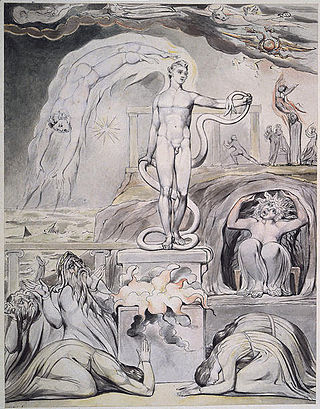
On the Morning of Christ's Nativity is a nativity ode written by John Milton in 1629 and published in his Poems of Mr. John Milton (1645). The poem describes Christ's Incarnation and his overthrow of earthly and pagan powers. The poem also connects the Incarnation with Christ's Crucifixion.
Upon the Circumcision is an ode by John Milton that was possibly written in 1633 and first published in 1645. It discusses the Feast of the Circumcision of Christ and connects Christ's Incarnation with his Crucifixion.
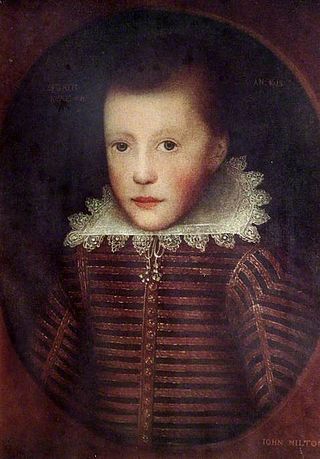
John Milton wrote poetry during the English Renaissance. He was born on 9 December 1608 to John and Sara Milton. Only three of their children survived infancy. Anne was the oldest, John was the middle child, and Christopher was the youngest.

In 1819, John Keats composed six odes, which are among his most famous and well-regarded poems. Keats wrote the first five poems, "Ode on a Grecian Urn", "Ode on Indolence", "Ode on Melancholy", "Ode to a Nightingale", and "Ode to Psyche" in quick succession during the spring, and he composed "To Autumn" in September. While the exact order in which Keats composed the poems is unknown, some critics contend that they form a thematic whole if arranged in sequence. As a whole, the odes represent Keats's attempt to create a new type of short lyrical poem, which influenced later generations.
The pastoral elegy is a poem about both death and idyllic rural life. Often, the pastoral elegy features shepherds. The genre is actually a subgroup of pastoral poetry, as the elegy takes the pastoral elements and relates them to expressing grief at a loss. This form of poetry has several key features, including the invocation of the Muse, expression of the shepherd's, or poet's, grief, praise of the deceased, a tirade against death, a detailing of the effects of this specific death upon nature, and eventually, the poet's simultaneous acceptance of death's inevitability and hope for immortality. Additional features sometimes found within pastoral elegies include a procession of mourners, satirical digressions about different topics stemming from the death, and symbolism through flowers, refrains, and rhetorical questions. The pastoral elegy is typically incredibly moving and in its most classic form, it concerns itself with simple, country figures. In ordinary pastoral poems, the shepherd is the poem's main character. In pastoral elegies, the deceased is often recast as a shepherd, despite what his role may have been in life. Further, after being recast as a shepherd, the deceased is often surrounded by classical mythology figures, such as nymphs, fauns, etc. Pastoral elegy is one of the forms of poems in Elizabethan poetry.
"Monody on the Death of Chatterton" was composed by Samuel Taylor Coleridge in 1790 and was rewritten throughout his lifetime. The poem deals with the idea of Thomas Chatterton, a poet who committed suicide, as representing the poetic struggle.
Nationality words link to articles with information on the nation's poetry or literature.
Religious Musings was composed by Samuel Taylor Coleridge in 1794 and finished by 1796. It is one of his first poems of critical merit and contains many of his early feelings about religion and politics.
Frost at Midnight is a poem by Samuel Taylor Coleridge, written in February 1798. Part of the conversation poems, the poem discusses Coleridge's childhood experience in a negative manner and emphasizes the need to be raised in the countryside. The poem expresses hope that Coleridge's son, Hartley, would be able to experience a childhood that his father could not and become a true "child of nature". The view of nature within the poem has a strong Christian element in that Coleridge believed that nature represents a physical presence of God's word and that the poem is steeped in Coleridge's understanding of Neoplatonism. Frost at Midnight has been well received by critics, and is seen as the best of the conversation poems.

"Mariana" is a poem by Alfred, Lord Tennyson, published in 1830. The poem follows a common theme in much of Tennyson's work—that of despondent isolation. The subject of "Mariana" is a woman who continuously laments her lack of connection with society. The isolation defines her existence, and her longing for a connection leaves her wishing for death at the end of every stanza. The premise of "Mariana" originates in William Shakespeare's Measure for Measure, but the poem ends before Mariana's lover returns. Tennyson's version was adapted by others, including John Everett Millais and Elizabeth Gaskell, for use in their own works. The poem was well received by critics, and it is described by critics as an example of Tennyson's skill at poetry.
References
- Corns, Thomas. "'On the Morning of Christ's Nativity', 'Upon the Circumcision' and 'The Passion'" in A Companion to Milton. Ed. Thomas Corns. Oxford: Blackwell Publishing, 2003.
- Kerrigan, William; Rumrich, John; and Fallon, Stephen (eds).The Complete Poetry and Essential Prose of John Milton. New York: The Modern Library, 2007.
- Shawcross, John. John Milton: The Self and the World. Lexington: University Press of Kentucky, 1993.
